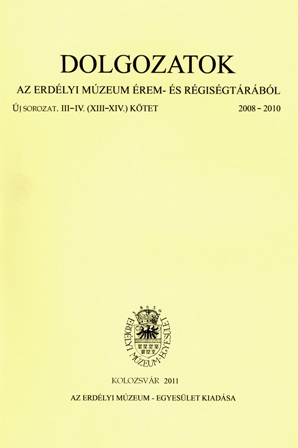A Tiszai kultúra települése Arad megyében
A Settlement of the Tisza Culture from Arad County
Author(s): György Goldman, Júlia SzénászkySubject(s): History, Archaeology, Cultural history, Ancient World
Published by: Erdélyi Múzeum-Egyesület
Keywords: Neolithic; Tisza culture; archaeological excavations
Summary/Abstract: In 1906 a group of finds dated in the Neolithic period belonging to the Körös, Szakálhát and Tisza cultures were brought into the museum from Békéscsaba. They were discovered on the mound called Vezeristye-halom, situated in the outskirts of Gyulavarsánd village (Romanian: Vărșand, Arad County). Later on, in 1949, archaeological excavations were carried out in the same location by Dorin Popescu. The authors of the article analyze the objects deposited in the museum from Békéscsaba. On the basis of the finds from Gyulavarsánd-Vezeristye-halom it is impossible to bring new information regarding the chronological aspects of the Tisza culture. At the same time, it is sure that the site belongs to the big tell settlements of the Tisza culture, and therefore – similar to the other sites belonging to the same culture – its existence began in the period of the Szakálhát culture. The big tell settlements of the period, from south to north, are the following: Csóka-Kremenyák, Battonya-Parázs tanya, Tápé-Lebő A and B, Hódmezővásárhely-Gorzsa, Hódmezővásárhely-Kökénydomb, Szegvár-Tőzköves, Öcsöd-Kováshalom, Szarvas-Botanikus kert (Botanical Garden), Békés-Povád, Szeghalom-Kovácshalom, Dévaványa-Sártó, Vésző-Mágor, Szolnok-Tőzköves, Alattyán-Tulát. Without any doubt, the settlement from Battonya-Gödrösök can be considered a Tisza culture tell, too. Taking into account its characteristics and its 2.1 meter high stratigraphy, the authors consider that Gyulavarsánd-Vezeristye-halom can be added to the abovementioned list. The big extension of the tell was already mentioned by Nándor Krammer, who estimated its surface around one cadastral acre, which means 0.575 hectare. According to the schematic plan of the site published by D. Popescu, the Neolithic settlement was almost circular, measuring approximately 1.1 hectares.
Journal: Dolgozatok az Erdélyi Múzeum Érem- és Régiségtárából. Új sorozat
- Issue Year: 2010
- Issue No: III-V
- Page Range: 5-13
- Page Count: 9
- Language: Hungarian

